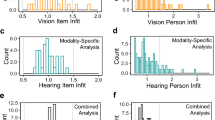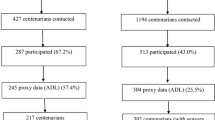Abstract
The purpose of the study was to describe the prevalence of hearing difficulties, vision difficulties and dual sensory difficulties in 11 European countries, and to study whether sensory difficulties are associated with social inactivity in older Europeans. This cross-sectional study is based on the 2004 data collection of the Survey of Health, Ageing and Retirement in Europe comprising 27,536 men and women aged 50 years and older. Hearing and vision difficulties, as well as participation in seven different social activities were assessed using a structured computer-assisted personal interview. Logistic regression models were used for analyses. Altogether, 5.9 % of the participants reported both hearing and vision difficulties (dual sensory loss), 10.2 % vision difficulties only, and 13.5 % hearing difficulties only. More than two-thirds (68.6 %) of the participants with dual sensory loss were socially inactive compared to half of those who reported no sensory difficulties. The participants who reported dual sensory loss had 2.18 (95 % CI 1.83–2.59) times higher odds for social inactivity compared to persons without hearing or vision difficulties. In a model adjusted for age, gender, mobility, depressive symptoms, cognition, education and wealth the corresponding odds ratio was 1.21 (95 % CI 1.00–1.47). According to our results, sensory difficulties were associated with social inactivity, but the higher likelihood for social inactivity among persons with sensory difficulties was attenuated by other health and socio-economic indicators. Our results suggest that various preventive and rehabilitative actions targeting older persons’ sensory functions may enhance their social activity.

Similar content being viewed by others
References
Alma MA, van der Mei SF, Melis-Dankers BJ, van Tilburg TG, Groothoff JW, Suurmeijer TP (2011) Participation of the elderly after vision loss. Disabil Rehabil 33:63–72
Avendano M, Jürges H, Mackenbach JP (2009) Educational level and changes in health across Europe: longitudinal results from SHARE. J Eur Soc Policy 19:301–316
Avlund K, Lund R, Holstein BE, Due P (2004a) Social relations as determinant of onset of disability in aging. Arch Gerontol Geriatr 38:85–99
Avlund K, Lund R, Holstein BE, Due P, Sakari-Rantala R, Heikkinen RL (2004b) The impact of structural and functional characteristics of social relations as determinants of functional decline. J Gerontol B Psychol Sci Soc Sci 59:S44–S51
Börsch-Supan A, Jürges H (eds) (2005) The survey of health, aging, and retirement in Europe: methodology. Mannheim Research Institute for the Economics of Aging, Mannheim
Brabyn JA, Schneck ME, Haegerstrom-Portnoy G, Lott LA (2007) Dual sensory loss: overview of problems, visual assessment, and rehabilitation. Trends Amplif 11:219–226
Brennan M, Bally SJ (2007) Psychosocial adaptations to dual sensory loss in middle and late adulthood. Trends Amplif 11:281–300
Brennan M, Horowitz A, Su Y (2005) Dual sensory loss and its impact on everyday competence. Gerontologist 45:337–346
Brennan M, Su YP, Horowitz A (2006) Longitudinal associations between dual sensory impairment and everyday competence among older adults. J Rehabil Res Dev 43:777–792
Bukov A, Maas I, Lampert T (2002) Social participation in very old age: cross-sectional and longitudinal findings from BASE. Berlin aging study. J Gerontol B Psychol Sci Soc Sci 57:P510–P517
Chia EM, Mitchell P, Rochtchina E, Foran S, Golding M, Wang JJ (2006) Association between vision and hearing impairments and their combined effects on quality of life. Arch Ophthal 124:1465–1470
Chiao C, Weng LJ, Botticello AL (2011) Social participation reduces depressive symptoms among older adults: an 18-year longitudinal analysis in Taiwan. BMC Public Health 11:292
Christelis D, Jappelli T, Padula M (2005a) Generated asset variables in SHARE Release 1. In: Börsch-Supan A, Jürges H (eds) The survey of health, aging and retirement in Europe: methodology. Mannheim Research Institute for the Economics of Ageing, Mannheim, pp 114–127
Christelis D, Jappelli T, Padula M (2005b) Wealth and portfolio composition. In: Börsch-Supan A, Brugiavini A, Jürges H, Mackenbach JP, Siegrist J, Weber G (eds) Health, ageing and retirement in Europe: first results from the survey of health. Research Institute for the Economics of Ageing, Mannheim, pp 310–317
Christensen K, Doblhammer G, Rau R, Vaupel J (2009) Ageing populations: the challenges ahead. Lancet 374:1196–1208
Crews JE, Campbell VA (2004) Vision impairment and hearing loss among community-dwelling older Americans: implications for health and functioning. Am J Public Health 94:823–829
De Luca G, Rossetti C (2011) Weights in the first three waves of SHARE. SHARE Survey of health, ageing and retirement in Europe. Release guide 2.5.0. Waves 1 & 2. Mannheim Research Institute for the Economics of Aging, Mannheim, pp 40–47
Dewey M, Prince M (2005) Cognitive function. In: Börsch-Supan A, Brugiavini A, Jürges H, Mackenbach J, Siegrist J, Weber G (eds) Health, ageing and retirement in Europe: first results from the survey of health, ageing and retirement in Europe. Mannheim Research Institute for the Economics of Ageing, Mannheim, pp 118–125
European Commission (2011) Active ageing and solidarity between generations: a statistical portrait of the European Union 2012. Publications Office of the European Union, Luxembourg
Glei DA, Landau DA, Goldman N, Chuang YL, Rodriguez G, Weinstein M (2005) Participating in social activities helps preserve cognitive function: an analysis of a longitudinal, population-based study of the elderly. Int J Epidemiol 34:864–871
Gopinath B, Rochtchina E, Wang JJ, Schneider J, Leeder SR, Mitchell P (2009) Prevalence of age-related hearing loss in older adults: Blue Mountains study. Arch Intern Med 169:415–416
Hannula S, Bloigu R, Majamaa K, Sorri M, Mäki-Torkko E (2011) Self-reported hearing problems among older adults: prevalence and comparison to measured hearing impairment. J Am Acad Audiol 22:550–559
Harada S, Nishiwaki Y, Michikawa T et al (2008) Gender difference in the relationships between vision and hearing impairments and negative well-being. Prev Med 47:433–437
Heine C, Browning CJ (2002) Communication and psychosocial consequences of sensory loss in older adults: overview and rehabilitation directions. Disabil Rehabil 24:763–773
Holt-Lunstad J, Smith TB, Layton JB (2010) Social relationships and mortality risk: a meta-analytic review. PLoS Med 7:e1000316
Horowitz A, Brennan M, Reinhardt JP (2005) Prevalence and risk factors for self-reported visual impairment among middle-aged and older adults. Res Aging 27:307–326
Isaac V, Stewart R, Artero S, Ancelin ML, Ritchie K (2009) Social activity and improvement in depressive symptoms in older people: a prospective community cohort study. Am J Geriatr Psychiatry 17:688–696
Jürges H (2005) Interview, module, and question length in SHARE. In: Börsch-Supan A, Jürges H (eds) The survey of health, aging, and retirement in Europe: methodology. Mannheim Research Institute for the Economics of Aging, Mannheim, pp 82–87
Kiely KM, Gopinath B, Mitchell P, Browning CJ, Anstey KJ (2012) Evaluating a dichotomized measure of self-reported hearing loss against gold standard audiometry: prevalence estimates and age bias in a pooled national data set. J Aging Health 24:439–458
Lee P, Smith JP, Kington R (1999) The relationship of self-rated vision and hearing to functional status and well-being among seniors 70 years and older. Am J Ophthalmol 127:447–452
Levasseur M, Richard L, Gauvin L, Raymond E (2010) Inventory and analysis of definitions of social participation found in the aging literature: proposed taxonomy of social activities. Soc Sci Med 71:2141–2149
Lin MY, Gutierrez PR, Stone KL, Yaffe K, Ensrud KE, Fink HA et al (2004) Vision impairment and combined vision and hearing impairment predict cognitive and functional decline in older women. J Am Geriatr Soc 52:1996–2002
McDonnall MC (2011) Physical status as a moderator of depressive symptoms among older adults with dual sensory loss. Rehabil Psychol 56:67–76
Merabet L, Pascual-Leone A (2010) Neural reorganization following sensory loss: the opportunity of change. Nat Rev Neurosci 11:44–52
Nilsson CJ, Avlund K, Lund R (2011) Onset of mobility limitations in old age: the combined effect of socioeconomic position and social relations. Age Ageing 40:607–614
Norris ML, Cunningham DR (1981) Social impact of hearing loss in the aged. J Gerontol 36:727–729
Prince MJ, Reischies F, Beekman AT, Fuhrer R, Jonker C, Kivelä SL et al (1999) Development of the EURO-D scale: a European, Union initiative to compare symptoms of depression in 14 European centres. Br J Psychiatry 174:330–338
Pynnönen K, Törmäkangas T, Heikkinen RL, Rantanen T, Lyyra TM (2012) Does social activity decrease risk for institutionalization and mortality in older people? J Gerontol B Psychol Sci Soc Sci 67:765–774
Saunders GH, Echt KV (2007) An overview of dual sensory impairment in older adults: perspectives for rehabilitation. Trends Amplif 11:243–258
Schneck ME, Lott LA, Haegerstrom-Portnoy G, Brabyn JA (2012) Association between hearing and vision impairments in older adults. Ophthalmic Physiol Opt 32:45–52
Schneider JM, Gopinath B, McMahon CM, Leeder SR, Mitchell P, Wang JJ (2011) Dual sensory impairment in older age. J Aging Health 23:1309–1324
Schneider J, Gopinath B, McMahon C, Teber E, Leeder SR, Wang JJ, Mitchell P (2012) Prevalence and 5-year incidence of dual sensory impairment in an older Australian population. Ann Epidemiol 22:295–301
Steinman BA, Allen SM (2012) Self-reported vision impairment and its contribution to disability among older adults. J Aging Health 24:307–322
Tesch-Römer C, von Kondratowitz H-J (2006) Comparative ageing research: a flourishing field in need of theoretical cultivation. Eur J Ageing 3:155–167
United Nations Educational Scientific and Cultural Organization (2006) International standard classification of education—ISCED 1997. Re-edition (2006) http://www.uis.unesco.org/Library/Documents/isced97-en.pdf. Accessed 25 March 2013
Viljanen A, Kaprio J, Pyykkö I, Sorri M, Koskenvuo M, Rantanen T (2009) Hearing acuity as a predictor of walking difficulties in older women. J Am Geriatr Soc 57:2282–2286
Viljanen A, Kulmala J, Rantakokko M, Koskenvuo M, Kaprio J, Rantanen T (2012) Fear of falling and coexisting sensory difficulties as predictors of mobility decline in older women. J Gerontol A Biol Sci Med Sci 67:1230–1237
Wallhagen MI, Strawbridge WJ, Shema SJ, Kurata J, Kaplan GA (2001) Comparative impact of hearing and vision impairment on subsequent functioning. J Am Geriatr Soc 49:1086–1092
Wilkie R, Peat G, Thomas E, Croft P (2006) The prevalence of person-perceived participation restriction in community-dwelling older adults. Qual Life Res 15:1471–1479
Wilkie R, Peat G, Thomas E, Croft P (2007) Factors associated with participation restriction in community-dwelling adults aged 50 years and over. Qual Life Res 16:1147–1156
Wittich W, Watanabe DH, Gagne J (2012) Sensory and demographic characteristics of deaf blindness rehabilitation clients in Montreal, Canada. Ophthalmic Physiol Opt 32:242–251
World Health Organization (2001) International classification of functioning, disability and health. World Health Organization, Geneva
Yamada M, Nishiwaki Y, Michikawa T, Takebayashi T (2012) Self-reported hearing loss in older adults is associated with future decline in instrumental activities of daily living but not in social participation. J Am Geriatr Soc 60:1304–1309
Acknowledgments
This paper uses data from SHARE wave 1 release 2.5.0, as of May 24th 2011. The SHARE data collection has been primarily funded by the European Commission through the 5th Framework Programme (project QLK6-CT-2001-00360 in the thematic programme Quality of Life), through the 6th Framework Programme (projects SHARE-I3, RII-CT-2006-062193, COMPARE, CIT5-CT-2005-028857, and SHARELIFE, CIT4-CT-2006-028812) and through the 7th Framework Programme (SHARE-PREP, No 211909, SHARE-LEAP, No 227822 and SHARE M4, No 261982). Additional funding from the US National Institute on Aging (U01 AG09740-13S2, P01 AG005842, P01 AG08291, P30 AG12815, R21 AG025169, Y1-AG-4553-01, IAG BSR06-11 and OGHA 04-064) and the German Ministry of Education and Research as well as from various national sources is gratefully acknowledged (see www.share-project.org for a full list of funding institutions). This study was financially supported by the Academy of Finland (Grant numbers 251723, 263729 to AV).
Author information
Authors and Affiliations
Corresponding author
Additional information
Responsible editor: H.-W. Wahl.
Rights and permissions
About this article
Cite this article
Viljanen, A., Törmäkangas, T., Vestergaard, S. et al. Dual sensory loss and social participation in older Europeans. Eur J Ageing 11, 155–167 (2014). https://doi.org/10.1007/s10433-013-0291-7
Published:
Issue Date:
DOI: https://doi.org/10.1007/s10433-013-0291-7




